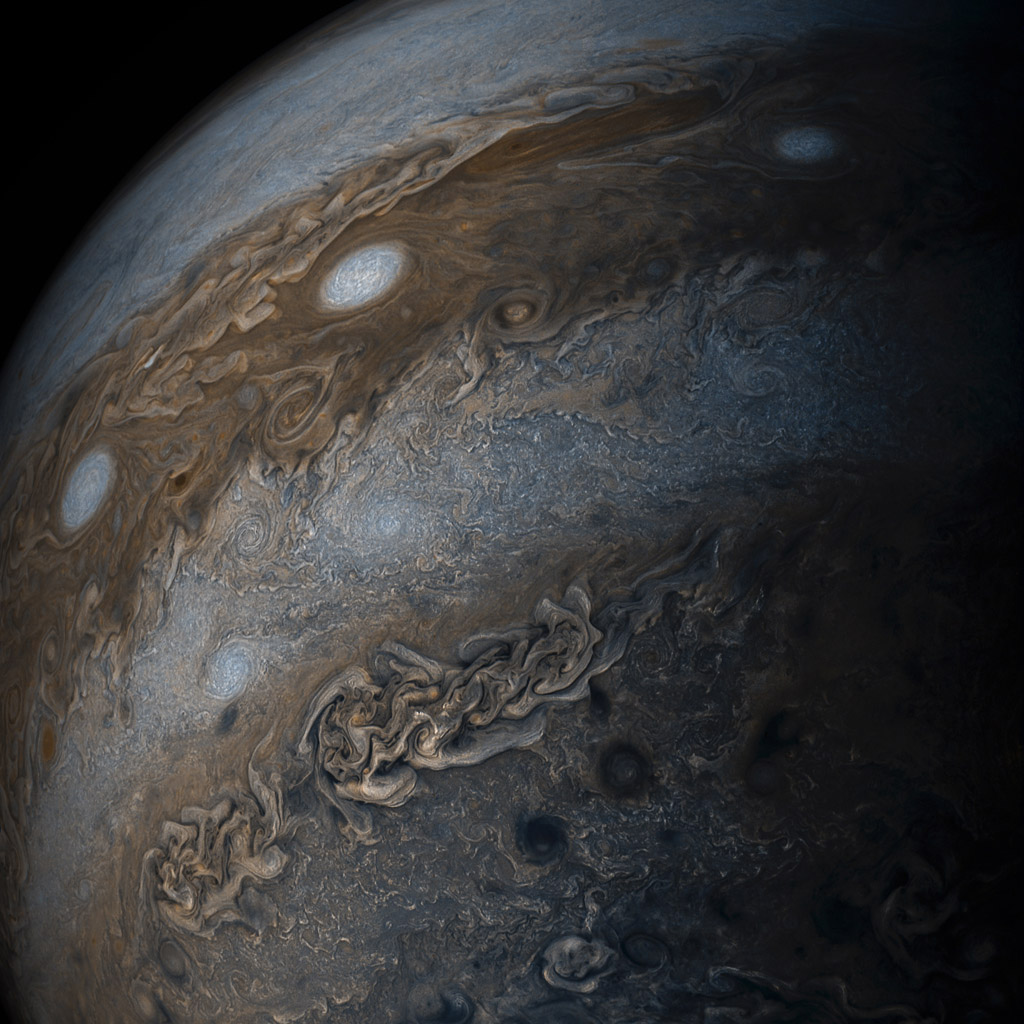
NASA's Juno spacecraft has now been orbiting the solar system's largest planet for a year.
Juno arrived at Jupiter on July 4, 2016, after a nearly five-year trek through deep space. Ever since its arrival, the probe has been peering at the gas giant intently, gathering data that should help scientists better understand Jupiter's formation and evolution.
"The success of science collection at Jupiter is a testament to the dedication, creativity and technical abilities of the NASA-Juno team," Juno project manager Rick Nybakken, from NASA's Jet Propulsion Laboratory in Pasadena, California, said in a statement. [Photos: NASA's Juno Mission to Jupiter]
"Each new orbit brings us closer to the heart of Jupiter's radiation belt, but so far the spacecraft has weathered the storm of electrons surrounding Jupiter better than we could have ever imagined," Nybakken added.
Juno's orbit is 53.5 Earth days long and extremely elliptical, bringing the spacecraft within 2,100 miles (3,400 kilometers) of Jupiter at closest approach, or perijove, and taking the spacecraft as far away as 5 million miles (8 million km).
Juno gathers most of its data during its close approaches, and the probe has completed five of them so far (not counting the initial orbital-arrival perijove), racking up a total of 71 million miles (114.5 million km) in orbit, NASA officials said.
But perijove number six is imminent, and it promises to be pretty exciting: On July 10, Juno will zoom directly over Jupiter's Great Red Spot, giving humanity its first up-close look at the famous 10,000-mile-wide (16,000 km) storm, which scientists have been monitoring from afar for nearly 200 years.
Get the Space.com Newsletter
Breaking space news, the latest updates on rocket launches, skywatching events and more!
"This monumental storm has raged on the solar system's biggest planet for centuries," Juno principal investigator Scott Bolton, from the Southwest Research Institute in San Antonio, said in the same statement. "Now, Juno and her cloud-penetrating science instruments will dive in to see how deep the roots of this storm go, and help us understand how this giant storm works and what makes it so special."
The $1.1 billion Juno mission launched on Aug. 5, 2011. The spacecraft took a looping path through the inner solar system to set up a speed-boosting flyby of Earth, which took place in October 2013.
Juno carries seven different science instruments, which the probe uses to study Jupiter's structure, composition, and magnetic and gravitational fields. Juno's observations so far suggest that Jupiter may have a large, partially dissolved core and that Jovian auroras are fundamentally different from those of Earth. The spacecraft has also spotted surprising cyclones near the huge planet's poles.
Juno's mission is scheduled to last through at least February 2018.
The probe's Jupiter arrival isn't the only anniversary NASA is celebrating today. An impactor released by the agency's Deep Impact spacecraft slammed into Comet Tempel 1 on July 4, 2005, and the Pathfinder lander touched down on Mars on the same date in 1997.
Follow Mike Wall on Twitter @michaeldwall and Google+. Follow us @Spacedotcom, Facebook or Google+. Originally published on Space.com.
Join our Space Forums to keep talking space on the latest missions, night sky and more! And if you have a news tip, correction or comment, let us know at: community@space.com.

Michael Wall is a Senior Space Writer with Space.com and joined the team in 2010. He primarily covers exoplanets, spaceflight and military space, but has been known to dabble in the space art beat. His book about the search for alien life, "Out There," was published on Nov. 13, 2018. Before becoming a science writer, Michael worked as a herpetologist and wildlife biologist. He has a Ph.D. in evolutionary biology from the University of Sydney, Australia, a bachelor's degree from the University of Arizona, and a graduate certificate in science writing from the University of California, Santa Cruz. To find out what his latest project is, you can follow Michael on Twitter.









